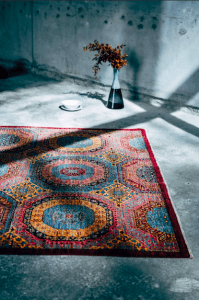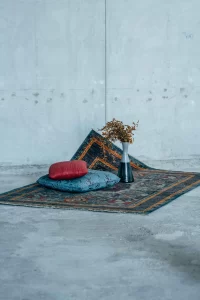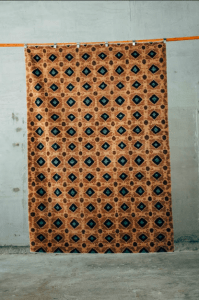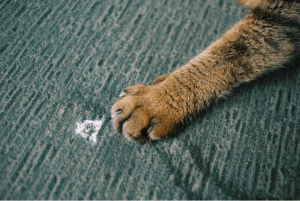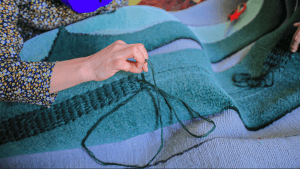A single thread can carry centuries of tradition. A carpet, woven by hand, becomes a tapestry of identity, memory, and meaning.
In the Middle East, carpets are more than floor coverings—they are storytellers, passed down from one generation to the next.
From the grand courts of Persian empires to the cozy sitting rooms of today’s homes, Middle Eastern carpets have shaped spaces and preserved culture.
In this blog, we’ll journey through the rich history of carpet weaving in the region, explore their deep cultural significance, and understand the craftsmanship that continues to define handmade Afghan rugs today.
The History of Carpets in the Middle East
The history of carpets in the Middle East traces back thousands of years to Persia, Mesopotamia, and Central Asia.
The oldest known knotted carpet, the Pazyryk Carpet, dates back to the 5th century BCE and was found in Siberia, believed to have originated from Persia or Armenia.
As civilizations flourished, so did carpet-making. From the Safavid dynasty in Iran to the Ottoman Empire, rulers commissioned rugs not only for utility but as symbols of wealth and grandeur. These carpets were often traded like treasures, spreading techniques and motifs throughout the region and into Europe and Asia.
Why Carpets Matter in Middle Eastern Culture?
The cultural significance of carpets in Middle Eastern societies goes beyond aesthetics.
Carpets are frequently used in prayer, hospitality, and life milestones, from births to weddings. A handwoven rug is a gift of meaning, often passed down as a family heirloom.
In tribal communities, the motifs woven into carpets symbolize protection, fertility, and identity. The act of weaving itself is considered a meditative, almost sacred process, one that connects the maker to her ancestry and community.
Afghan Carpets and Their Unique Craftsmanship
Among the most revered contributors to this art form are Afghan handmade carpets.
Woven by skilled artisans, many of them women, these carpets are known for their deep reds, bold geometric patterns, and durable quality. Each piece is a blend of tribal identity and artistic excellence, embodying the timeless appeal of traditional carpets admired across generations.
Afghanistan’s complex history has not diminished its carpet legacy.
In fact, it has enriched it. Refugee camps, rural villages, and urban workshops continue to produce world-class rugs, each narrating a story of resilience and tradition.
Hand-Knotted vs Hand-Tufted: What’s the Difference?
Two techniques dominate traditional carpet making: hand-knotted and hand-tufted rugs. Both are intricate, but they differ in process and purpose.
Hand-Knotted Rugs
Hand-knotted rugs are the pinnacle of traditional craftsmanship. Each knot is tied individually, often taking artisans several months to complete a single piece. This labor-intensive method results in highly durable, intricate rugs with fine detail and character. The density and precision of these carpets make them heirloom-quality pieces, treasured for their uniqueness and longevity.
Hand-Tufted Rugs
Hand-tufted rugs are made by punching yarn into a canvas using a tufting gun, allowing artisans to replicate complex designs more quickly. Though less time-consuming than hand-knotting, this method still relies on skilled hands. The result is a high-quality, visually appealing carpet that offers a balance between craftsmanship and affordability—ideal for those seeking artisanal style with shorter production timelines.
Both styles reflect a rich carpet weaving tradition, with artisans embedding their narratives and region-specific aesthetics into each thread.
Modern Carpet Weaving in the Middle East
Despite modernization, the tradition of carpet weaving thrives across the Middle East. Artisans continue to use natural dyes, wool, and hand-spun yarns. Global demand for authentic, ethically-made carpets is driving a revival in handwoven goods.
Today’s interiors blend the old with the new, and many homes feature modern carpets that reinterpret traditional patterns with contemporary colors, minimalist styles, and innovative materials,offering a fresh take on an ancient craft.
In many communities, weaving provides economic empowerment—especially for women—and a way to keep cultural identity alive in an ever-globalizing world.
Keeping the Carpet Tradition Alive
Carpets in the Middle East are not merely household items—they are enduring emblems of art, faith, and identity. Their intricate patterns and textures offer a glimpse into the heart of a region rich in tradition.
One example of preserving this heritage is Zuleya, a Dubai-based initiative that brings the beauty of Afghan handmade carpets to modern interiors. By partnering with Afghan women artisans, Zuleya ensures that centuries-old craftsmanship continues to thrive today—each rug a story, each knot a legacy. For more information, call 800-ZULEYA, or email info@zuleya.ae.
Frequently Asked Questions
Middle Eastern carpets are unique due to their intricate designs, natural dyes, symbolic motifs, and historical techniques passed down through generations.
Hand-knotted carpets are more labor-intensive and durable, involving knotting each thread individually. Hand-tufted carpets are quicker to make using a tufting gun, offering similar beauty at a lower price point.
Afghan carpets are renowned for their deep colors, tribal patterns, and craftsmanship. Made with hand-spun wool and natural dyes, they embody both resilience and tradition.
They play roles in religious practice, hospitality, family heritage, and artistic expression. Carpets are often used in prayer, celebrations, and as status symbols.
Carpet weaving provides income, independence, and cultural connection for Afghan women. Programs like Zuleya support these women by offering global platforms for their work.

